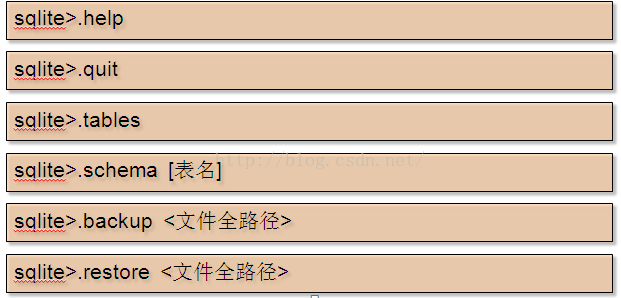视频课:https://edu.csdn.net/course/play/7621
本章内容
第 1 节 SQLite 数据库概述
第 2 节 SQLite 建库建表
第 3 节 管理数据库连接
第 4 节 操作数据库数据
第 5 节 数据绑定
本章目标
掌握 SQLite 数据的基本特点与工具使用。
熟练掌握 SQLite 建库建表的方法。
熟练掌握连接 SQLite 数据库的方法。
熟悉 SQLite 数据库的升级与建立方法。
掌握通过数据绑定完成数据显示的方法。
SQLite数据库简介
SQLite是一种非常流行的嵌入式数据库,是由C语言编写而成,是一款轻型关系型数据库,支持SQL,支持多种操作系统,完全独立运行,没有依赖性,Android内嵌了SQLite数据库。
SQLite数据库工具是用来操作数据库文件的工具,官方网站提供了命令行工具的下载。
http://www.sqlite.org/download.html
下载sqlite-shell-******.zip文件
解压缩后只有一个文件sqlite3,将sqlite3所在的路径加入path环境变量,Sqlite3工具的使用,连接数据库文件。
$ sqlite3 <数据库文件路径>
SQLite数据库工具是用来操作数据库文件的工具
uSqlite3工具的使用
Ø数据库的相关管理命令都是以.开头,常用命令如下

SQLite数据库工具是用来操作数据库文件的工具
sqlite3工具的使用,在sqlite3的命令行下可以直接输入标准sql语句,除了sqlite3以外,还有很多非官方的可视化管理工具
SQLite Database Browser
SQLite Expert Professional
SQLite Develope
SQLite与大型数据库的区别
两者都是支持关系的关系型数据库,SQLite是一个嵌入型的轻量级数据库,适合小数据量,大型数据库独立运行在数据库服务器上,适合大数据量级别,大型数据库通常以网络的方式对外提供服务。
创建 SQLite 数据库
$ sqlite3test.db
直接在命令行输入上面的命令,如果test.db不存在,则预创建(直到执行相关sql才创建文件),如果test.db存在,则连接数据库
$ sqlite3test.db <sql.script
上述命令可以在创建数据库的同时使用sql.script进行初始化
SQLite数据库的数据类型
SQLite数据中的列可以存储任意数据类型的数据
为了与其他数据库兼容,可以为字段指定默认的类型
NULL:空值
INTEGER: 带符号的整数,具体取决于存入数字的范围大小
REAL:浮点数,存储为8-bytes的浮点数
TEXT:字符串文本
BLOB:二进制对象
同时还接受如下一些类型:
smallint 16位整数
int 32位整数
float 32位浮点数
double 64位浮点数
SQLite数据库的数据类型
为了与其他数据库兼容,可以为字段指定默认的类型
同时还接受如下一些类型:
char(n) n不能炒作254
varchar(n) n不能超过4000
date
time
limestamp
创建SQLite数据表,通过SQL语句创建表
create table books (id integer primary key autoincrement,name varchar(128) not null unique,author varchar(128) not null,price double not null);
创建表间关联(也就是通过外键建立关系)
create table groups(id integer primary key autoincrement,name varchar(128) not null unique);crate table users(id integer primary key autoincrement,group_id integer constraint fk_users_group_id references groups(id),username varchar(128) not nullpassword varchar(128) not null);
事务控制
SQLite支持数据库事务
sqlite> begin;sqlite> insert into ……sqlite> commit;sqlite> rollabck;
Android系统中SQLite数据库文件的保存位置
默认情况下,数据库文件保存在如下目录中:
/data/data/<应用程序包>/databases
用户也可以指定将文件保存在任意有权限的目录中,通常SD卡中的目录都可以,在Android系统中连接数据库,使用SQLiteDatabase类连接数据库
SQLiteDatabase db = SQLiteDatabase.openOrCreateDatabase(dbFile, null);
通过SQLiteOpenHelper类来连接数据库
public class MyHelper extends SQLiteOpenHelper {public static final int VERSION = 1;public static final String DATABASE_NAME = “test.db”;public MyHelper(Context context) {super(context, DATABASE_NAME, null, VERSION);}}
SQLiteDatabase db = helper.getWritableDatabase();
数据库升级与存在性检测,当应用升级的时候,需要检测数据库是否存在,或者是否要升级,SQLiteOpenHelper提供了创建与升级的能力
public MyHelper(Context context) {super(context, DATABASE_NAME, null, VERSION);}
覆盖onCreate(SQLiteDatabase db)方法,完成创建任务
public void onCreate(SQLiteDatabase db) {String str_sql = "CREATE TABLE " + TABLE_NAME+ "(” + ID + " INTEGER PRIMARY KEYAUTOINCREMENT,”+ TEXT + " text);";db.execSQL(str_sql);}
数据库升级与存在性检测,覆盖onUpdate方法,完成升级任务
public void onUpgrade(SQLiteDatabase db, int oldVersion, int newVersion) {//这里填写数据库升级操作的代码}
合理关闭数据库连接
不再使用或长时间不用时,应关闭数据库连接
程序退出时
程序暂停时
不再需要操作数据库时
使用SQLiteDatabase类中的close方法关闭连接
执行查询(假设已经存在了数据库连接句柄db)
在SQLiteDatabase中提供了如下方法用于查询
execSQL
insert、insertOrThrow、insertWithOnConflict
query、rawQuery
replace、replaceOrThrow
update、updateWithOnConflict
delete
执行查询(假设已经存在了数据库连接句柄db),插入记录示例
//将一条新记录的各个字段内容装入一个ContentValues对象ContentValues cv = new ContentValues();cv.put("name",user.getName());cv.put("age",user.getAge());cv.put("remark",user.getRemark());//插入一条新记录db.insert("users",null, cv);
执行查询(假设已经存在了数据库连接句柄db)
u删除记录示例
//第一个参数为表名//第二个参数表示where后的条件表达式,可以使用?//第三个参数则是一个对应每一个?值的数组db.delete("users", "id=?", new String[]{String.valueOf(userId)});
更新记录示例
ContentValues cv = new ContentValues();cv.put("name", user.getName());cv.put("age", user.getAge());cv.put("remark", user.getRemark());db.update("users", cv, "id=?",new String[]{String.valueOf(userId)});
执行查询(假设已经存在了数据库连接句柄db)
u单表查询所有记录示例
Cursor c = db.query("users", null, null, null, null, null, "name");List<User> users = null;if(c != null) {users = new ArrayList<User>();while(c!=null && c.moveToNext()) {User u = new User();u.setId(c.getInt(0));u.setName(c.getString(1));u.setAge(c.getInt(2));u.setRemark(c.getString(3));users.add(u);}c.close();}
执行查询(假设已经存在了数据库连接句柄db)
单表条件查询记录示例
Cursor c = db.query(“users”, //表名new String[]{“name”, “age”}, //select包含的字段 “age > ?”, //where条件表达式new String[]{“10”}, //条件值null, //group子句null, //having子句“name desc” //排序字段);
执行查询(假设已经存在了数据库连接句柄db)
任意SQL条件查询记录示例
String sql = “select name, age from users where age > ?”Cursor c = db.query(sqlnew String[]{“10”});
事务是确保数据库操作原子性的保障
SQLiteDatabase提供了如下方法用于事务处理
beginTransaction 开启事务
setTransactionSuccessful 提交事务
endTransaction 关闭事务,如果未提交事务,则自动rollback
db.beginTransaction(); //开始事务try {…… //这里填写数据库操作代码db.setTransactionSuccessful(); //提交事务} finally {db.endTransaction(); //关闭事务}
数据绑定的必要性
数据绑定是指将界面和数据进行绑定,在界面和数据之间建立绑定模式有助于数据的呈现
Adapter其实就是界面和数据之间绑定的桥梁,将视图和数据绑定后将会降低维护数据的复杂度
SimpleCursorAdapter提供了数据层的数据绑定桥梁
SimpleCursorAdapter可以将数据库层的数据提供给列表
1、准备一个列表项的布局用于ListView的展现
<LinearLayout xmlns:android="http://schemas.android.com/apk/res/android"android:layout_width="match_parent"android:layout_height="match_parent"android:orientation="horizontal" ><TextView android:id="@+id/nametextview“ android:layout_width="0dp“android:layout_height="40dp“ android:layout_weight="1"/><TextView android:id="@+id/agetextview“ android:layout_width="80dp"android:layout_height="40dp"/></LinearLayout>
SimpleCursorAdapter可以将数据库层的数据提供给列表
2、使用SimpleCursorAdapter展现数据
ListView bookListView = (ListView)findViewById(R.id.booklist);String [] from = new String[] { "_name", "_age“ };int [] to = new int[] { R.id.nametextview, R.id.agetextview };Cursor cursor = db.rawQuery(“select * from books”, null);SimpleCursorAdapter adapter = new SimpleCursorAdapter(MainActivity.this, R.layout.book_list_item, cursor, from, to, 0);bookListView.setAdapter(adapter);
修改绑定数据
有时候直接展现的数据可能不符合要求,需要转变后展示,可以通过SimpleCursorAdapter.ViewBinder接口来实现
修改的步骤如下:
1、编写一个类实现SimpleCursorAdapter.ViewBinder接口
SimpleCursorAdapter.ViewBinder viewBinder = new SimpleCursorAdapter.ViewBinder() {public boolean setViewValue(View view, Cursor cursor, int columnIndex) {if(cursor.getColumnIndex("_name") == columnIndex) {TextView v = (TextView)view;v.setText("N:" + cursor.getString(columnIndex));return true;}return false;}};
修改绑定数据
修改的步骤如下:
2、使用ViewBinder修改数据
ListView bookListView = (ListView)findViewById(R.id.booklist);String [] from = new String[] { "_name", "_age“ };int [] to = new int[] { R.id.nametextview, R.id.agetextview };Cursor cursor = db.rawQuery(“select * from books”, null);SimpleCursorAdapter adapter = new SimpleCursorAdapter(MainActivity.this, R.layout.book_list_item, cursor, from, to, 0);adapter.setViewBinder(viewBinder);bookListView.setAdapter(adapter);